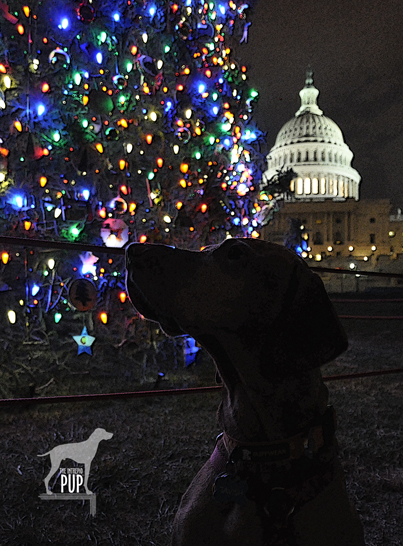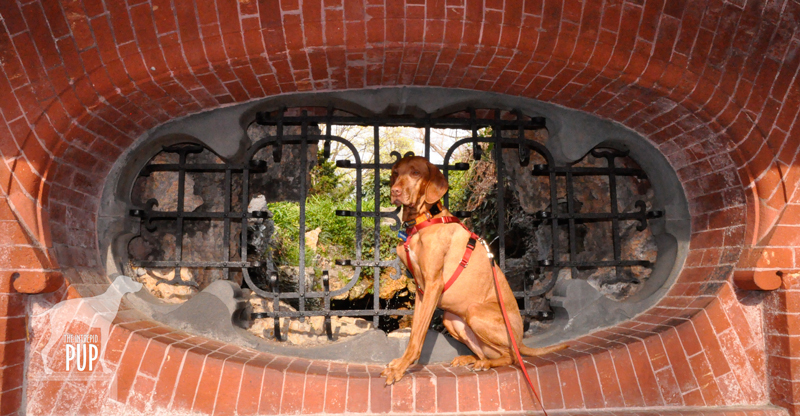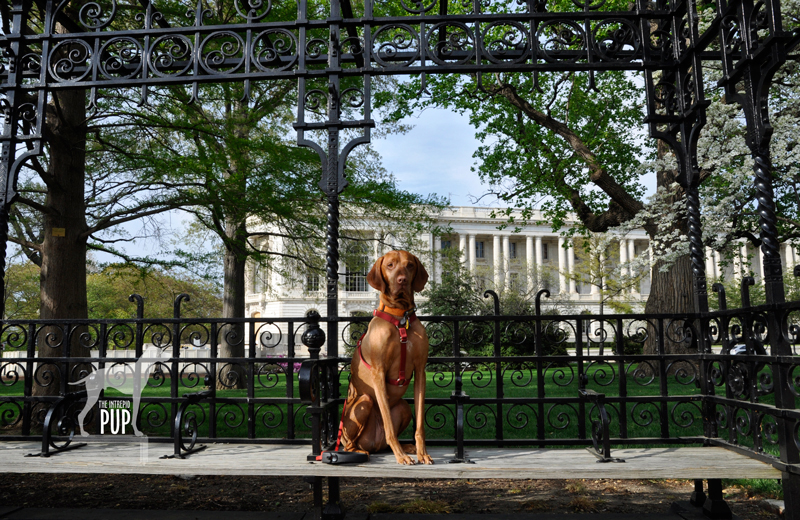
GO FIGURE: Intrepid Pup particularly liked the theme for the 2012 Capitol tree: “The Great Outdoors”! Culled from the White River National Forest in Colorado, this 74-year-old Engelmann spruce made stops in 30 different towns en route to Washington, DC. The tour was sponsored in part by Choose Outdoors, an organization dedicated to connecting Americans to public lands through outdoor recreation. The tree stands 73 feet tall and is laden with approximately 3,000 ornaments, most of which were handmade by Colorado schoolchildren.
With the holiday season comes an explosion of colorful decorations. Elaborate displays crop up in downtowns across America, and for a few short weeks everything takes on the magical luster that only twinkle lights can impart. The Washington, DC metro area is particularly picturesque in December, and the weather is usually still temperate enough that touring around is not a completely frigid proposition.
Over the next several posts, Tavish the Intrepid Pup will give you an insider’s tour of the national “howl-iday” scene, scoping out what are arguably among the most iconic—and dog-friendly—holiday spots the capital region has to offer.
* * *
Tavish’s first destination is the 2012 Christmas Tree on the grounds of the United States Capitol.
The original Capitol Christmas tree was a Douglas fir specifically planted on the property in 1964 to fulfill that role. When it eventually succumbed to storm damage, the Architect of the Capitol enlisted the help of the U.S. Department of Agriculture’s Forest Service to sustain the holiday tradition. Every year since 1970, the trees destined for Capitol Hill have been cut and harvested from various national forests. Citizens from the home state supply thousands of handcrafted ornaments showcasing aspects of their state’s heritage, earning the Capitol tree the apt designation as the “People’s Tree.”
 Dogging the Details
Dogging the Details
38°53′23.24″N, 77°0′40.19″W
United States Capitol Christmas Tree, Washington, DC
The 2012 tree is on view December 4 – 26, 2012.
While the Capitol tree is one of Team Tavish‘s favorites in the metro DC region, it’s also the most fleeting. The cut tree arrives shortly after Thanksgiving and takes a little more than a week to be secured and decorated before a public tree-lighting ceremony with the Architect of the Capitol and the Speaker of the House in early December. Thereafter, the tree is illuminated nightly from dusk to 11 pm until shortly after Christmas.
Timed parking on the street and in nearby surface lots makes the Capitol tree readily accessible during the evening hours. The large West Lawn can accommodate a LOT of people before ever seeming crowded, and that truly distinguishes this setting from some of the others on the “howl-iday scene.” You can get right up close to the tree without being rushed or jostled, and that makes it great for checking out the diversity and creativity of the decorations. This year’s tree is an Engelmann spruce from Colorado, so many of the ornaments depict Colorado wildlife, mining and skiing-related imagery, and symbols from Native American tribes.
On the evening of our visit, construction related to President Obama’s upcoming second inaugural was well underway on the Capitol portico and lawn. . . perhaps explaining why this year’s tree will only be on view through December 26. The 7,000 LED bulbs produce a riot of color, with the luminous dome of the Capitol providing a signature backdrop for photographs.
Tavish was the only dog in sight when we arrived, although a couple more arrived as we were leaving. Tavish seemed more than content to pose with the tree and sniff at the low-hanging boughs. Remember to keep your dog on-leash (the area is patrolled by Capitol Police) and bring bags to clean up; trash receptacles are located by the gateways on First Street, S.W.
The comparative lack of crowds makes this outing a pleasant one for dogs and humans alike. Combine that with the ability to capture some great holiday photos at a truly unique venue, and this excursion gets a “3” on the Intrepid Pup’s wag-a-meter.













